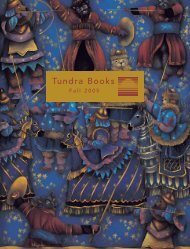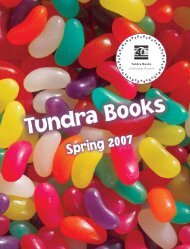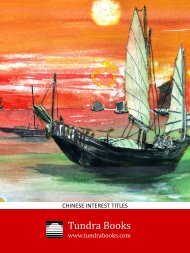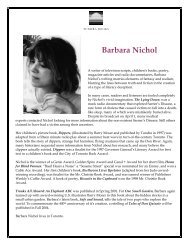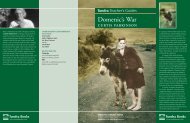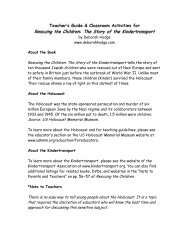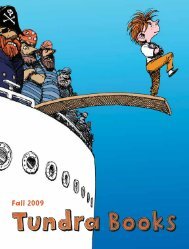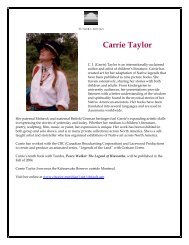World Vision Early Readers - Tundra Books
World Vision Early Readers - Tundra Books
World Vision Early Readers - Tundra Books
You also want an ePaper? Increase the reach of your titles
YUMPU automatically turns print PDFs into web optimized ePapers that Google loves.
I like to Play Grades K-3<br />
1. What are the children in this photo doing?<br />
2. Where are the children playing? What and who are they<br />
playing with?<br />
3. How are the children in this photo feeling? How can<br />
you tell?<br />
4. Make the same actions as the children playing in this<br />
photo.<br />
5. Does anything in the photos surprise you?<br />
6. How is this similar to or different from the way you play?<br />
7. What would you like to know more about after looking<br />
at these photos?<br />
After Reading: Reflecting<br />
Ask: What did you learn about the ways children in other<br />
countries play? What games or toys would you like to try?<br />
Did the children remind you of yourself or anyone you<br />
know? Explain.<br />
Give each student a large sticky note paper and ask them<br />
to write or draw something new they learned after reading<br />
the book. Have students share orally what they learned and<br />
post their sticky notes in the L column of the KWL chart.<br />
Suggested I Like to Play Art<br />
Activities: Grades 4–6<br />
3D Paper Sculptures<br />
Students explore the element of lines used in art by constructing<br />
3D paper sculptures depicting scenes of children<br />
at play. Brainstorm different types of lines (straight, curvy,<br />
squiggly, zigzag, etc.) and have students find examples of<br />
lines in the class or school environment. The following site<br />
provides lessons about the element of lines in art:<br />
Princeton Online: Incredible Arts Department<br />
http://www.princetonol.com/groups/iad/lessons/early/ElementExtravaganza.html<br />
Ask students to imagine an ideal place to play. Give each<br />
one a large piece of stock paper or cardboard for building<br />
a 3D sculpture of that ideal place. Have students create<br />
different types of lines using construction paper strips of<br />
varying lengths and shapes. They may cut, curl, fold, tear,<br />
curve, twist and glue the paper strips together to make<br />
their scenes. For example, students might create a dream<br />
playground. Encourage them to add details to the scene<br />
such as paper cut-outs of children playing. The following<br />
sites show examples of how to create 3D paper sculptures:<br />
Making Friends<br />
http://www.makingfriends.com/sculpture/sculppaper.htm<br />
Family Fun<br />
http://familyfun.go.com/crafts/crafts-by-material/papercrafts/artful-paper-crafts/paper-sculpture-674363/print/<br />
Create an Original Game<br />
Challenge older students to create an original movement<br />
game or board game, complete with simple rules. They can<br />
teach the game to their classmates in small groups or to<br />
younger students in the school. Provide a purpose or goal for<br />
the game, such as helping people to know each other better.<br />
Drama Activity: This is Not A…<br />
Sit with students in a circle. Bring out a common object,<br />
such as a scarf and say: “This is a scarf, but it’s not a scarf,<br />
it’s a…kite.” Make the scarf move like a kite. Pass it to the<br />
next player who says: “This is a kite, but it’s not a kite, it’s<br />
a…” and fills in with a new object, repeating the motion of<br />
a kite and then making the new motion. Continue passing<br />
the scarf around the circle, inviting students to complete<br />
the statement by repeating the idea and movement of the<br />
student before them and adding their own original ideas.<br />
Encourage them to generate as many possibilities as they<br />
can. Try the game with another common object, such as<br />
a pencil. This activity can be used to introduce themes or<br />
topics being studied in class by suggesting categories of<br />
objects (things that fly, things you need to survive, etc.).<br />
<strong>World</strong> <strong>Vision</strong> <strong>Early</strong> <strong>Readers</strong><br />
15




